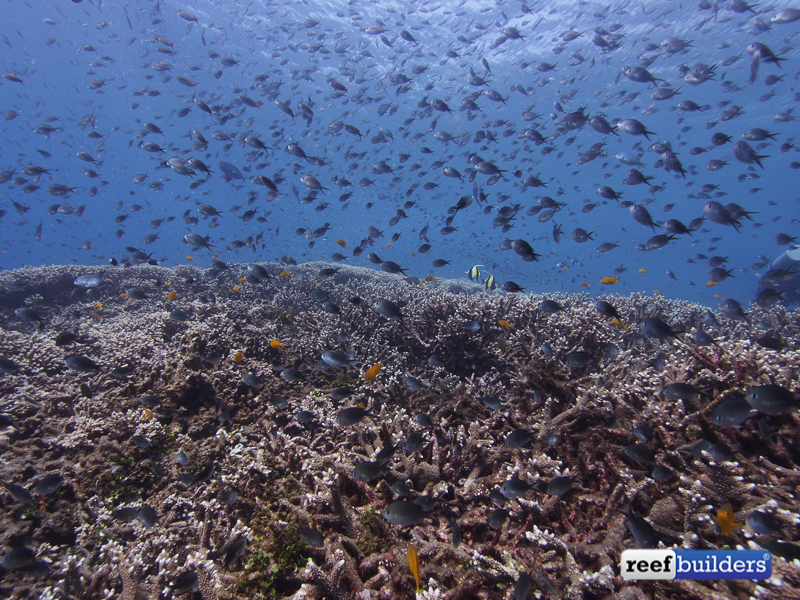After what seemed like a never ending flights, we finally arrived Tuesday night to Bali Aquarium, our home base for the next two months. The export facility is located in the capital city of Bali, Denpasar, and ships corals, fish and invertebrates all over the world. Bali Aquarium is one of the pioneers of maricultured aquarium corals in Indonesia and we will be here learning more about what goes into getting corals from the source to you. Chances are if you have any coral in you home aquarium from the Indo Pacific, there’s a good chance some of them probably passed through the raceways here at Bali aquarium!

November is the tail end of the dry season (hint the rain is coming) so our host Vincent Chalias took no delay in setting up a weekend full of diving. A quick (short) night’s sleep and we packed up our gear and hit the road for a three hour drive to Tulamben, on the north-east coast of Bali. Tulamben is among one of the most popular dive sites on the island, famous for the Liberty wreck, a US Army Transport ship torpedoed by a Japanese submarine in 1942.
We have to admit, “most popular dive site in Bali” wasn’t our idea of a good time! Nope we are on the hunt for dive sites off the beaten path. Lucky for us, Vincent has spent the better part of twenty years in Bali so he knew just where to go.
Day 1 for our first dive we headed 45 minutes west of Tulamben to Taman Segara Penuktukan. What is interesting about this dive site are the concrete ball-shaped artificial reef structures placed around 9 meters deep (30 feet) which, are designed to be a place for corals to grow and fish to take shelter and spawn.

Tamar Segara was established in 2008 by a group of local conservationists, assisted by several NGOs including the Reef Check Foundation to protect the coastal and offshore areas of Penuktukan. Prior to 2008, the underwater site was under threat from non-local fishermen who used destructive bottom trawl nets, poison and explosives to catch fish. The group of local fishermen from Penuktukan formed the group to help protect the waters around their village.
Currently there are some 40 structures in the water with lots of large well developed colonies of branching Acropora. We found lots of fish living in the artificial reefs including some extra inquisitive trigger fish we had to fend off during the dive.
Day 2 of diving and we headed 30 minutes east of Tulamben to Amed. We did three dives, two starting at the Japanese shipwreck and one in Jemeluk. The shipwreck is a great snorkeling spot as it is shallow 3-5 meter deep (10-15 feet).

The shipwreck is covered in corals, and schools of fish like to hide in the protective hull, so it’s easy to spend lots of time looking around all the nooks and crannies. We found a trio of yellow leaf fish, at least a dozen azoox stony coral species inside the ship, and a stunning orange elephant ear coral.
In the shallow waters beyond the wreck is a garden of leather corals like Sarcophyton, Lobophytum and Sinularia, we also found a beautiful colony of Nephthea swaying with the swell in 3m (10 feet) or water. We also spotted our first peacock mantis shrimp and a red pygmy seahorse, Hippocampus bargibanti. Past the shallows, the bottom slopes to a deeper coral reef formation around 20-25 m (65-80 feet) deep covered in sea fans, stony corals and more fish that you could count.

Our last dive of the day was at Jemeluk and was one of my favorites. The dive started with a longer swim out over a sandy bottom covered in garden eels, then the shallow reef quickly turns into a sharp drop off down to 35m (115 feet). At the bottom we found some beautifully photogenic tunicates, Mycediums and Oxypora. Along the wall we also spotted some beautiful pink square anthias and large colonies of acropora reaching out from the ledge.
Day 3 took us to Kubu a short drive east of Tulamben. Kubu starts with a rubble bottom with lots of little critters hiding amounts the rocks. We found lots of Rhodactis mushroom anemones, montipora, Pocillopora, and large anemones with some fantastic and bold maroon clownfish.

Kubu is another sloping reef and was our deepest dive of the weekend; we had a max depth of 36m (120 feet) and it was one of those dive you wish you could stay all day in the water. The slope was full of micro habitats covered with large fields of Anacropora giving way to Acropora carduus (red dragon acropora) We especially loved watching the school of sergeant major damselfish darting around as 20 or more trevallies shot through the water chasing the school.
We headed back to Denpasar that afternoon for a day of well needed rest and lots of time to sift through our photos and to report back! There will be more to come throughout our stay about Bali Aquarium and especially coral farms and what is takes to get coral from here to all of you.
Make sure to stay connected through the coming weeks for more great stories and updates about our trip and follow us on Facebook, Instagram, YouTube and Pinterest.
[ngg_images source=”galleries” container_ids=”1295″ display_type=”photocrati-nextgen_pro_masonry” size=”180″ padding=”10″ ngg_triggers_display=”always” captions_enabled=”0″ captions_display_sharing=”1″ captions_display_title=”1″ captions_display_description=”1″ captions_animation=”slideup” order_by=”sortorder” order_direction=”ASC” returns=”included” maximum_entity_count=”500″]



